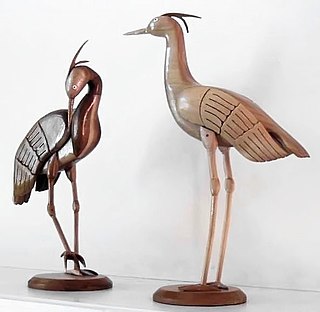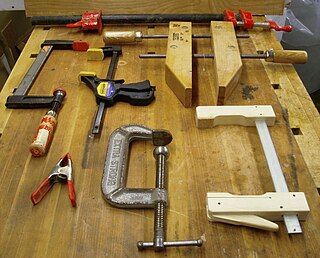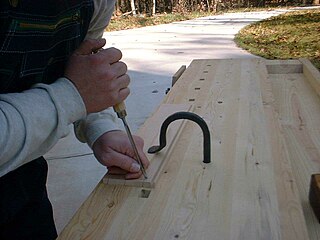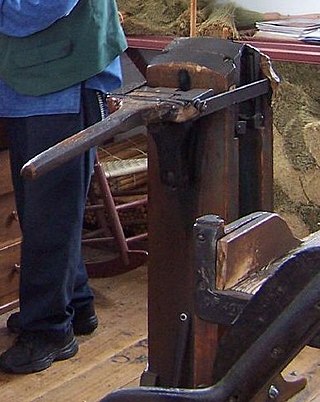
Woodworking is the skill of making items from wood, and includes cabinet making, wood carving, joinery, carpentry, and woodturning.

A lathe is a machine tool that rotates a workpiece about an axis of rotation to perform various operations such as cutting, sanding, knurling, drilling, deformation, facing, and turning, with tools that are applied to the workpiece to create an object with symmetry about that axis.

A clamp is a fastening device used to hold or secure objects tightly together to prevent movement or separation through the application of inward pressure. In the United Kingdom the term cramp is often used instead when the tool is for temporary use for positioning components during construction and woodworking; thus a G cramp or a sash clamp but a wheel clamp or a surgical clamp.

A workbench is a sturdy table at which manual work is done. They range from simple flat surfaces to very complex designs that may be considered tools in themselves. Workbenches vary in size from tiny jewellers benches to the huge benches used by staircase makers. Almost all workbenches are rectangular in shape, often using the surface, corners and edges as flat/square and dimension standards. Design is as varied as the type of work for which the benches are used but most share these attributes:

A wheellock, wheel-lock or wheel lock is a friction-wheel mechanism which creates a spark that causes a firearm to fire. It was the next major development in firearms technology after the matchlock and the first self-igniting firearm. Its name is from its rotating steel wheel to provide ignition. Developed in Europe around 1500, it was used alongside the matchlock and later the snaplock (1540s), the snaphance (1560s) and the flintlock.

A chuck is a specialized type of clamp used to hold an object with radial symmetry, especially a cylinder. In a drill, a mill and a transmission, a chuck holds the rotating tool; in a lathe, it holds the rotating workpiece.

A vise or vice is a mechanical apparatus used to secure an object to allow work to be performed on it. Vises have two parallel jaws, one fixed and the other movable, threaded in and out by a screw and lever.

A lathe center, often shortened to center, is a tool that has been ground to a point to accurately position a workpiece on an axis. They usually have an included angle of 60°, but in heavy machining situations an angle of 75° is used.

A bench hook is a workbench appliance used in woodworking to hold a workpiece in place while crosscutting with a hand saw. A bench hook is a simple method used to improve accuracy and safety.
The dog is a domesticated canid species, Canis familiaris.

A C-clamp or G-clamp or G-cramp is a type of clamp device typically used to hold a wood or metal workpiece, and often used in, but are not limited to, carpentry and welding. Often believed that these clamps are called "C" clamps because of their C-shaped frame, or also often called C-clamps or G-clamps because including the screw part, they are shaped like an uppercase letter G. However, in fact, they were originally called a carriage maker's clamp, or Carriage Clamp.
A pipe clamp is a type of clamp often employed in woodworking, piping or cabinet shops. When referring to woodwork or cabinet shops, pipe clamps are usually composed of commercially manufactured clamp heads or "jaws" and a length of common threaded pipe. The capacity of the clamp is determined by the length of the pipe used. When referring to piping, pipe clamps are used to connect the pipe to the pipe hanger assembly.

A holdfast or hold fast is a form of temporary clamp used to hold a workpiece firmly to the top or side of a wooden workbench or the top of an anvil.
This glossary of woodworking lists a number of specialized terms and concepts used in woodworking, carpentry, and related disciplines.
In engineering, a dog is a tool or part of a tool, such as a pawl, that prevents or imparts movement through physical engagement. It may hold another object in place by blocking it, clamping it, or otherwise obstructing its movement. Or it may couple various parts together so that they move in unison – the primary example of this being a flexible drive to mate two shafts in order to transmit torque. Some devices use dog clutches to lock together two spinning components. In a manual transmission, the dog clutches, or "dogs" lock the selected gear to the shaft it rotates on. Unless the dog is engaged, the gear will simply freewheel on the shaft.

A workbench is a specialized table used by woodworkers. Features include a flat, solid work surface and one or more means of holding the material being worked on.

A shaving horse is a combination of vice and workbench, used for green woodworking. Typical usage of the shaving horse is to create a round profile along a square piece, such as for a chair leg or to prepare a workpiece for the pole lathe. They are used in crafts such as coopering and bowyery.

The Black & Decker Workmate is a general purpose portable workbench and general carpentry tool manufactured under the brand Black & Decker. It is a folding table for portability, but when unfolded stands about 3 feet (1 m) tall. The table top consists of two wooden jaws, one of which is fixed and the other moveable on threaded rods operated by handles. It can be used as a bench vice to hold wood, metal and other parts, either clamped between the jaws or, using supplied bench dogs, clamped on the table top. The jaws are wide enough to hold most bench top tools, such as a drill press, planer, miter saw, etc.

The Shaker broom vise is a specialized production vise that made the normally round broom flat to make it more efficient for cleaning purposes. The Shakers' invention revolutionized the production and form of brooms; in the process greatly expanding an industry in New England.

A woodworking vise is a type of vise adapted to the various needs of woodworkers and woodworking. Several types have evolved to meet differing primary functions, falling under the general categories of front and end vises, reflecting their positions on a workbench.

















